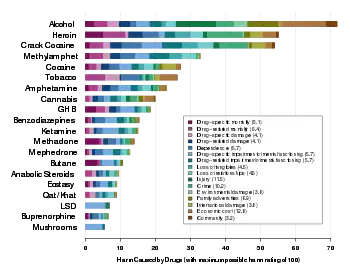Barbiturate overdose
| Barbiturate overdose | |
|---|---|
| Other names: Barbiturate poisoning, barbiturate toxicity | |
 | |
| Molecular diagram of phenobarbital | |
| Specialty | Emergency medicine |
| Symptoms | Decreased breathing, decreased level of consciousness[1] |
| Complications | Noncardiogenic pulmonary edema[2] |
| Duration | 6-12 hours[2] |
| Causes | Accidental, suicide[3] |
| Diagnostic method | Blood or urine tests[4] |
| Treatment | Breathing support, activated charcoal[5][6] |
| Frequency | Uncommon[7] |
Barbiturate overdose is poisoning due to excessive doses of barbiturates.[8] Symptoms typically include difficulty thinking, poor coordination, decreased level of consciousness, and a decreased effort to breathe (respiratory depression).[1] Complications of overdose can include noncardiogenic pulmonary edema.[2] If death occurs this is typically due to a lack of breathing.[3]
Barbiturate overdose may occur by accident or purposefully in an attempt to cause death.[3] The toxic effects are additive to those of alcohol and benzodiazepines.[3] The lethal dose varies with a person's tolerance and how the drug is taken.[3] The effects of barbiturates occur via the GABA neurotransmitter.[2] Exposure may be verified by testing the urine or blood.[4]
Treatment involves supporting a person's breathing and blood pressure.[2][5] While there is no antidote, activated charcoal may be useful.[5][6] Multiple doses of charcoal may be required.[7] Hemodialysis may occasionally be considered.[6] Urine alkalinisation has not been found to be useful.[6] While once a common cause of overdose, barbiturates are now a rare cause.[7]
Mechanism
Barbiturates increase the time that the chloride pore of the GABAA receptor is opened, thereby increasing the efficacy of GABA. In contrast, benzodiazepines increase the frequency with which the chloride pore is opened, thereby increasing GABA's potency.[9]
Treatment
Treatment involves supporting a person's breathing and blood pressure.[2][5] While there is no antidote, activated charcoal may be useful.[5][6] Multiple doses of charcoal may be required.[7] Hemodialysis may occasionally be considered.[6] Urine alkalinisation has not been found to be useful.[6]
If a person is drowsy but awake and can swallow and breathe without difficulty, the treatment can be as simple as monitoring the person closely. If the person is not breathing, it may involve mechanical ventilation until the drug has worn off. Psychiatric consult is generally recommended.
Notable cases
People who are known to have committed suicide by barbiturate overdose include, Gillian Bennett,[10]Charles Boyer, Ruan Lingyu, Dalida,[11][12] Jeannine "The Singing Nun" Deckers, Felix Hausdorff, Abbie Hoffman, Phyllis Hyman, C. P. Ramanujam, George Sanders, Jean Seberg, Lupe Vélez and the members of Heaven's Gate cult. Others who have died as a result of barbiturate overdose include Pier Angeli, Brian Epstein, Judy Garland, Jimi Hendrix, Marilyn Monroe, Inger Stevens, Dinah Washington, Ellen Wilkinson, and Alan Wilson; in some cases these have been speculated to be suicides as well. Those who died of a combination of barbiturates and other drugs include Rainer Werner Fassbinder, Dorothy Kilgallen, Malcolm Lowry, Edie Sedgwick and Kenneth Williams. Dorothy Dandridge died of either an overdose or an unrelated embolism. Ingeborg Bachmann may have died of the consequences of barbiturate withdrawal (she was hospitalized with burns, the doctors treating her not being aware of her barbiturate addiction).
Differential Diagnosis
The differential diagnosis includes intoxication by other substances with sedative effects, such as benzodiazepines, anticonvulsants (carbamazepine), alcohols (ethanol, ethylene glycol, methanol), opioids, carbon monoxide, sleep aids, and gamma-Hydroxybutyric acid (GHB). Diseases that can result in disorientation are in the differential, including hypoglycemia and myxedema coma. In the right setting, hypothermia should be ruled out.[13]
References
- 1 2 Weaver, MF (3 September 2015). "Prescription Sedative Misuse and Abuse". The Yale Journal of Biology and Medicine. 88 (3): 247–56. PMC 4553644. PMID 26339207.
- 1 2 3 4 5 6 Marx, John A. Marx (2014). "165". Rosen's emergency medicine : concepts and clinical practice (8th ed.). Philadelphia, PA: Elsevier/Saunders. pp. Sedative Hypnotics. ISBN 978-1455706051.
- 1 2 3 4 5 Sadock, Benjamin J.; Sadock, Virginia A. (2008). Kaplan & Sadock's Concise Textbook of Clinical Psychiatry. Lippincott Williams & Wilkins. p. 149. ISBN 9780781787468. Archived from the original on 2016-11-04.
- 1 2 Baren, Jill M. (2008). Pediatric Emergency Medicine. Elsevier Health Sciences. p. 955. ISBN 978-1416000877. Archived from the original on 2016-11-04.
- 1 2 3 4 5 Carroll, Robert G. (2010). Problem-based Physiology. Elsevier Health Sciences. p. 99. ISBN 978-1416042174. Archived from the original on 2016-11-04.
- 1 2 3 4 5 6 7 Roberts, DM; Buckley, NA (January 2011). "Enhanced elimination in acute barbiturate poisoning - a systematic review". Clinical Toxicology. 49 (1): 2–12. doi:10.3109/15563650.2010.550582. PMID 21288146.
- 1 2 3 4 Müller, D; Desel, H (October 2013). "Common causes of poisoning: etiology, diagnosis and treatment". Deutsches Ärzteblatt International. 110 (41): 690–9, quiz 700. doi:10.3238/arztebl.2013.0690. PMC 3813891. PMID 24194796.
- ↑ Publishing, Bloomsbury (2009). Dictionary of Medical Terms. Bloomsbury Publishing. p. 37. ISBN 9781408102091. Archived from the original on 2016-11-04.
- ↑ Lafferty, KA; Bonhomme, K; Kopinski, P; Lee, DC; Abdel-Kariem, R (14 January 2017). Tarabar, A; VanDeVoort, JT; Burns, MJ (eds.). "Barbiturate Toxicity: Pathophysiology". eMedicine. New York, USA: WebMD. Archived from the original on 26 August 2017. Retrieved 26 August 2017.
- ↑ "DeadAtNoon". deadatnoon.com. Archived from the original on 2020-11-06. Retrieved 2020-06-23.
- ↑ "Dalida". New York Times. 5 May 1987. Archived from the original on 26 May 2012. Retrieved 28 February 2008.
- ↑ Simmonds, Jeremy (2008). v. Chicago Review Press. p. 225. ISBN 978-1-55652-754-8. Archived from the original on 2016-05-18.
- ↑ Suddock, Jolee T.; Cain, Matthew D. (2020), "Barbiturate Toxicity", StatPearls, Treasure Island (FL): StatPearls Publishing, PMID 29763050, archived from the original on 2020-10-25, retrieved 2020-08-05
External links
| Classification | |
|---|---|
| External resources |
